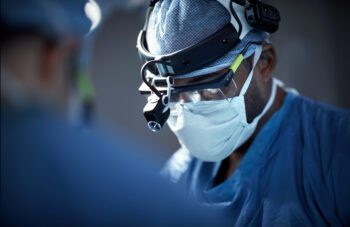Spinal disc replacement surgery, also known as artificial disc replacement (ADR) or total disc replacement (TDR), is a surgical procedure where a damaged or degenerated spinal disc is replaced with an artificial disc. This procedure is typically performed when other conservative treatments, such as physical therapy, medications, or injections, have failed to relieve pain and discomfort caused by disc degeneration.
Purpose of Spinal Disc Replacement
What It Treats
Disc replacement is used to treat conditions like degenerative disc disease (DDD), herniated discs, and chronic back or neck pain caused by disc damage. It is an alternative to spinal fusion surgery, which permanently joins two or more vertebrae together.
Goal of Spinal Disc Replacement
The goal of the surgery is to relieve pain, maintain or restore motion in the spine, and improve the patient’s quality of life. Unlike spinal fusion, which restricts movement by fusing vertebrae, disc replacement preserves the natural movement of the spine.
Candidates for Spinal Disc Replacement
- Ideal Candidates:
- Patients with degenerative disc disease or herniated discs causing chronic pain in the neck (cervical spine) or lower back (lumbar spine).
- Patients who have not found relief from non-surgical treatments such as medications, physical therapy, or injections.
- Patients in good overall health without significant spinal deformity, instability, or other complicating conditions.
- Not Ideal Candidates:
- People with severe spinal instability, advanced osteoporosis, severe scoliosis, or prior extensive spinal surgeries.
- Patients with infections, tumors, or systemic inflammation conditions of the spine.
Types of Spinal Disc Replacement
There are two main types of spinal disc replacement surgeries based on the location in the spine:
1. Lumbar Disc Replacement (Lower Back):
- Treats degenerative disc disease or herniated discs in the lumbar (lower back) region.
- Helps maintain motion in the lower back and reduce pressure on the spinal nerves.
2. Cervical Disc Replacement (Neck)
- Treats disc problems in the cervical (neck) spine, commonly due to herniation or degeneration causing nerve compression or radiculopathy.
- Helps maintain neck mobility and relieve nerve pain radiating into the arms or shoulders.
Procedure Overview
Anesthesia: The surgery is performed under general anesthesia, meaning the patient is asleep during the procedure.
Surgical Approach:
- Lumbar Disc Replacement: Typically performed through an incision in the abdomen (anterior approach). This avoids cutting through the back muscles, which can lead to a quicker recovery.
- Cervical Disc Replacement: Performed through an incision in the front of the neck (anterior approach), similar to the approach used in anterior cervical discectomy and fusion (ACDF).
Steps:
- The surgeon makes an incision to access the spine and removes the damaged or degenerated disc.
- The space between the vertebrae is cleared, and the artificial disc is carefully inserted into the disc space.
- The surgeon ensures proper alignment and fit of the artificial disc to restore natural spacing between the vertebrae and maintain motion.
- The incision is closed, and the patient is monitored for recovery.
Recovery
- Hospital Stay: Patients typically stay in the hospital for 1-3 days, depending on the extent of the surgery and individual recovery.
- Initial Recovery: Most patients can begin walking the day after surgery. However, lifting heavy objects and vigorous activity should be avoided for several weeks.
- Rehabilitation: Physical therapy is often prescribed to help restore strength, flexibility, and movement in the spine. Patients may return to light activities within a few weeks, but full recovery may take several months.
- Return to Normal Activities: Many patients can resume some activities, including light work, within a few weeks, though this varies based on each situation.
Risks and Complications
Like all surgeries, spinal disc replacement carries some risks, including:
- Infection: There is a risk of infection at the surgical site.
- Implant Failure: The artificial disc may wear out over time or dislodge, potentially requiring revision surgery.
- Nerve Injury: The surgery involves working near spinal nerves, so there is a risk of nerve damage, which can cause pain, numbness, or weakness.
- Blood Clots: As with most surgeries, there is a risk of developing blood clots in the legs (deep vein thrombosis).
- Persistent Pain: Some patients may continue to experience back or neck pain even after surgery.
- Adjacent Segment Degeneration: Over time, the segments of the spine above or below the replaced disc may degenerate.
Advantages of Disc Replacement vs. Spinal Fusion
- Preservation of Motion: Disc replacement maintains mobility in the spine, while spinal fusion eliminates movement between fused vertebrae.
- Reduced Stress on Adjacent Segments: Since disc replacement preserves motion, it may reduce the risk of adjacent segment degeneration, which is more common in fusion surgeries.
- Faster Recovery: Because disc replacement doesn’t involve bone grafting (as with fusion), patients may recover more quickly and return to normal activities sooner.
Long-Term Outlook
- Success Rates: Studies show that disc replacement surgery has a high success rate, with many patients experiencing significant pain relief and improved mobility. Success rates are often similar to or better than spinal fusion, depending on the condition.
- Durability: While artificial discs are designed to last for many years, the long-term durability of some devices is still being studied.
Summary
Spinal disc replacement surgery is an innovative, motion-preserving procedure for treating conditions like degenerative disc disease and herniated discs. It provides an alternative to spinal fusion by allowing patients to maintain spine mobility while reducing pain and improving function. It’s typically considered when conservative treatments fail, and the patient is otherwise in good health. As with any surgery, it’s essential to weigh the benefits and risks and discuss all options with a healthcare provider.



